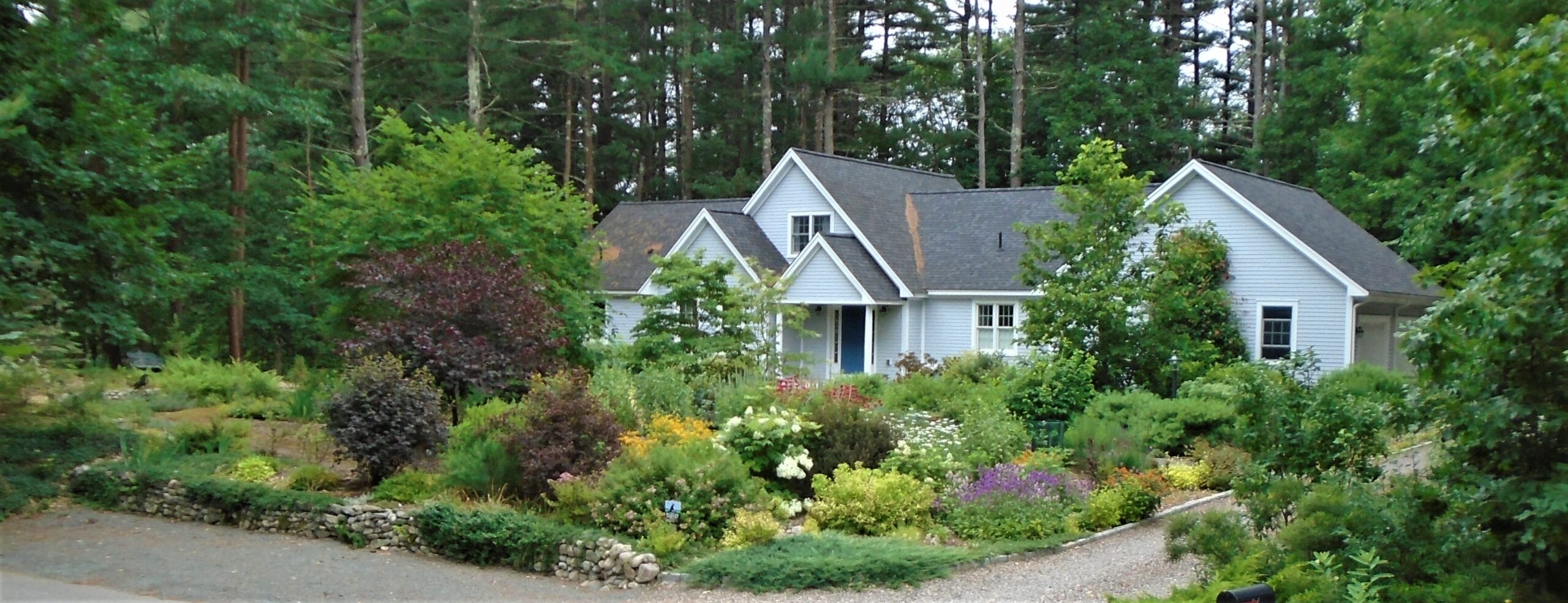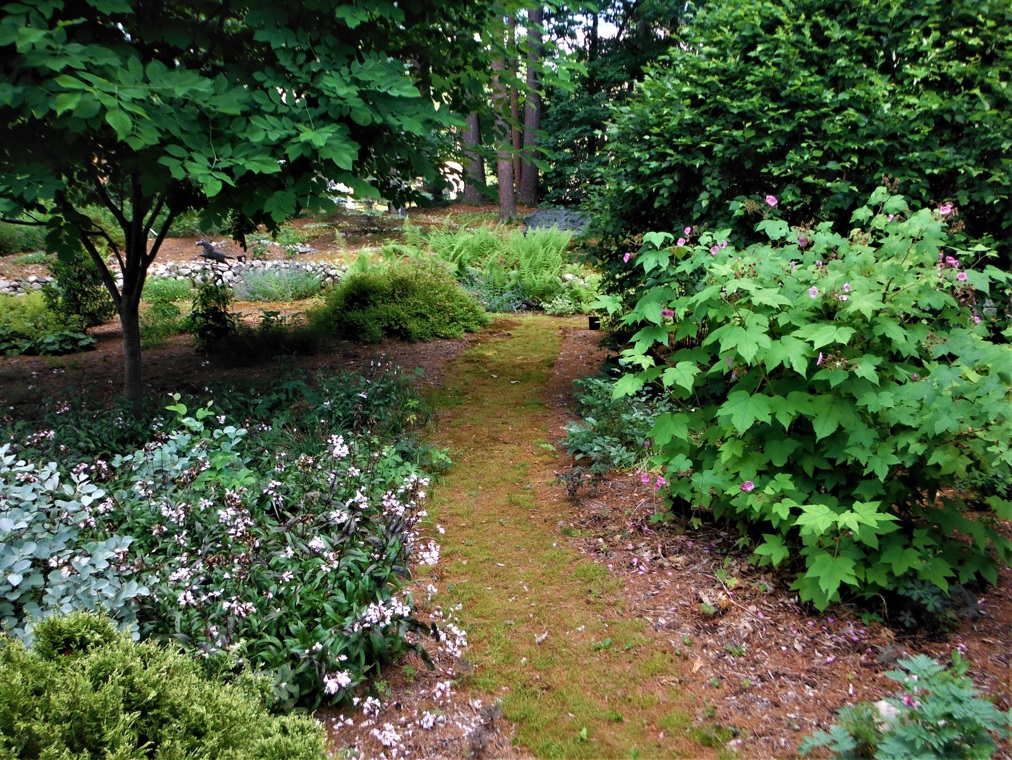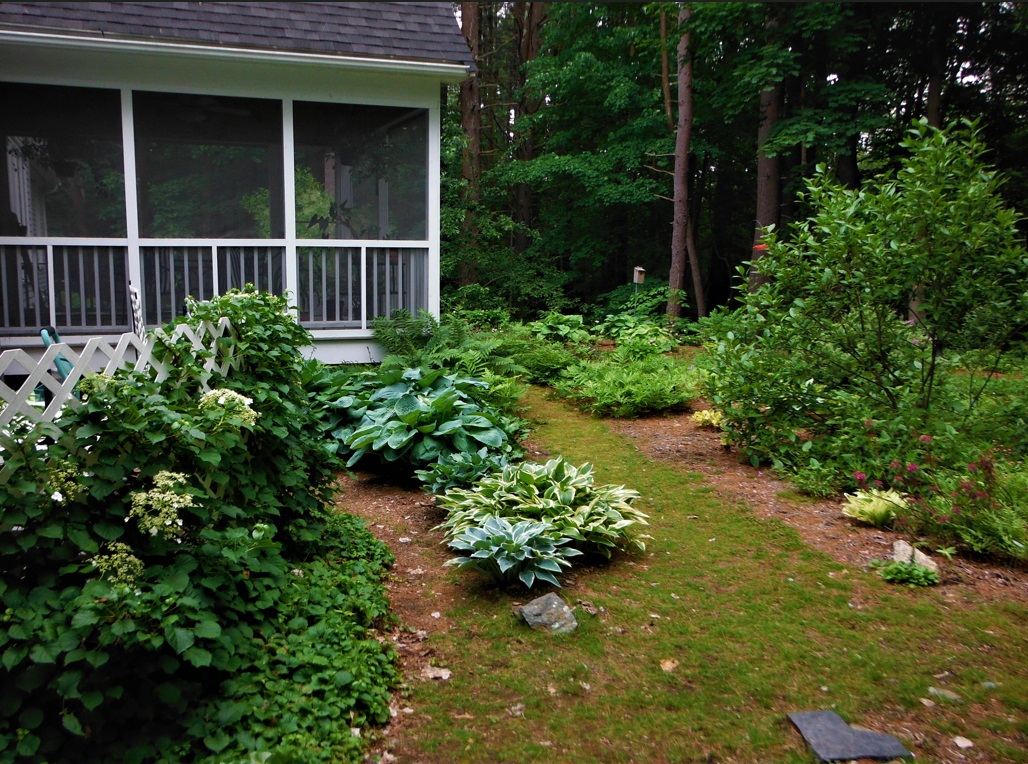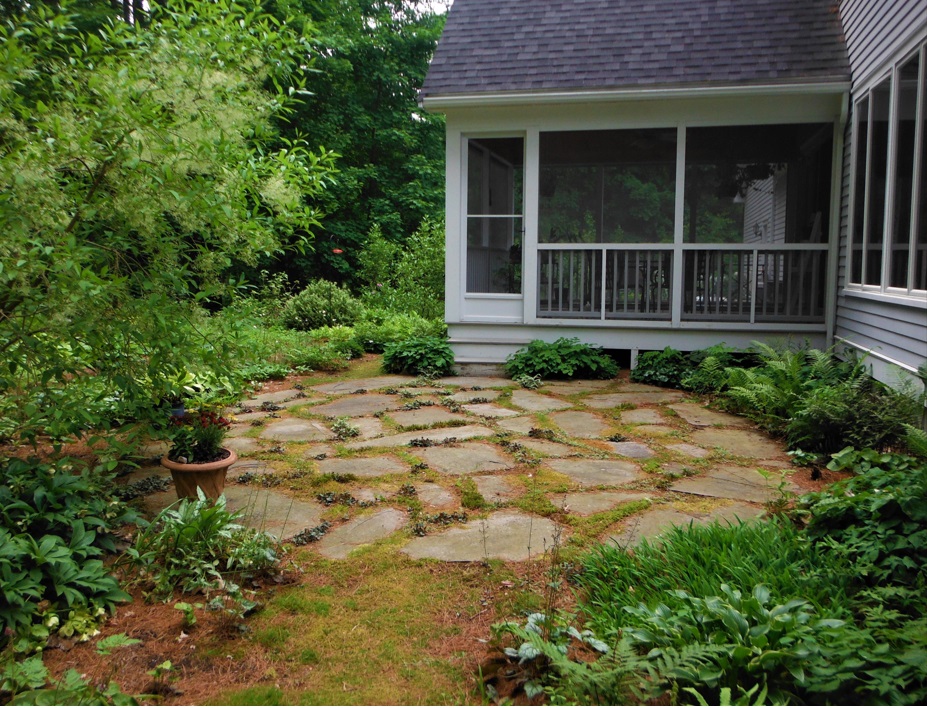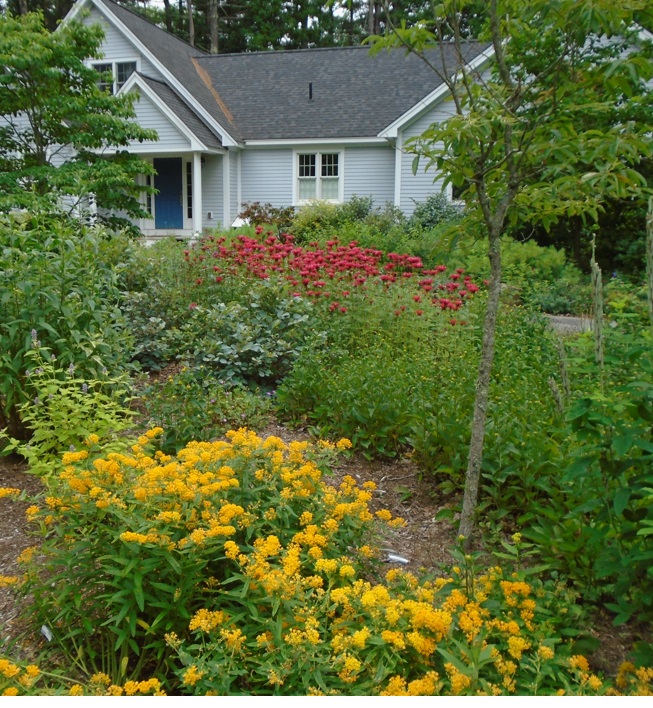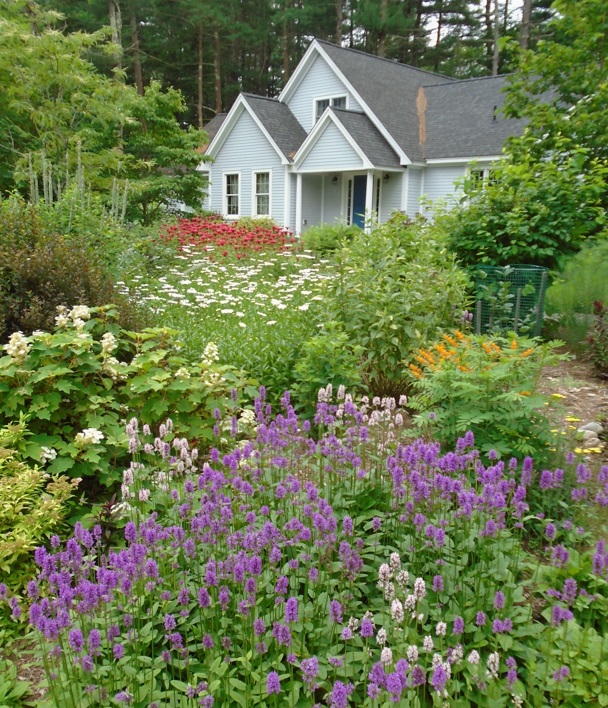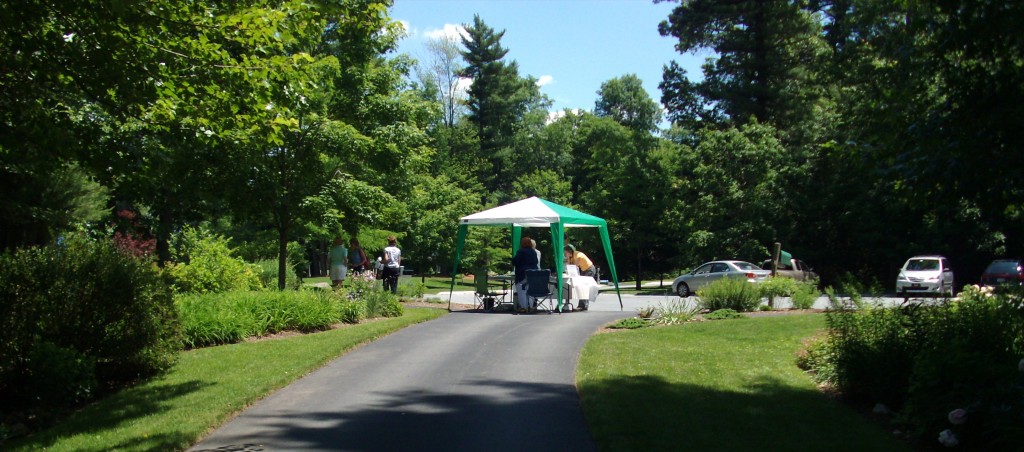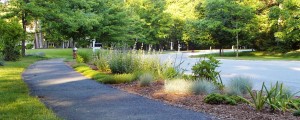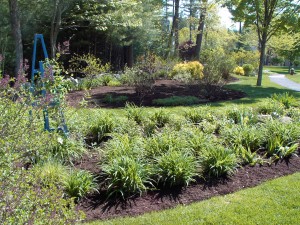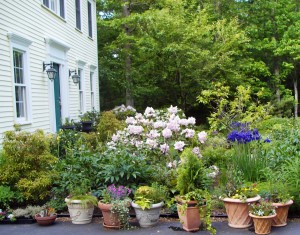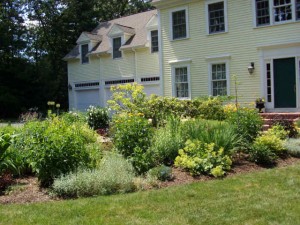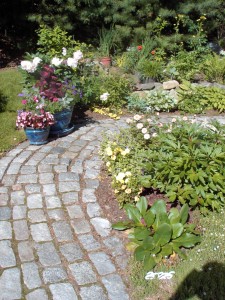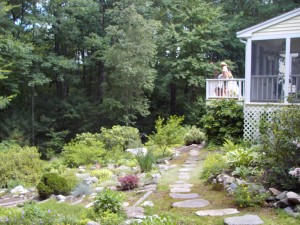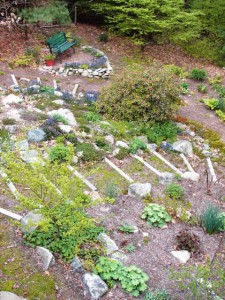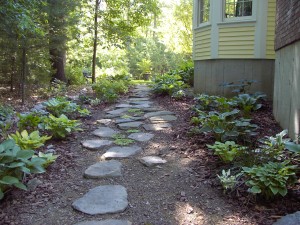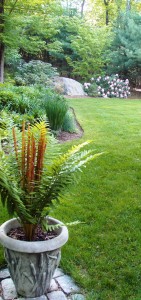A Visit to My Garden and Directions to My Blog
Contrary to popular wisdom (and to what you see on Castle), books do not magically appear while the author chases down bad guys or woos beautiful women. Writing is a job, albeit primarily a mental one. And, staying in shape is a must while you wait for the Big Idea to hatch in your mind. My way of exercising is through a blog. It is updated, on average, once a week with a 900-word essay. My chosen topic is gardening. Why gardening? Because I have nothing original to say about politics or wine (the two most popular blog topics). Well, maybe the topic is gardening because there is a horticultural theme to several of my books.
You’re invited to take a look at my blog on gardens, gardening, and gardeners. Click here to go to ‘The Principal Undergardener’ (or go to http://theprincipalundergardener.blogspot.com. To see my wife’s monthly gardening hints, go here (or go to www.BettyonGardening.com and click on ‘Horticultural Hints’)
26 Pine Street, Medfield
Our home since 2015 is a stunning, mostly native, garden than meets naturalist Doug Tallamy’s definition of a ‘Hometown National Park’. Here it is in July 2023:
And, here are some detail photos:
And some additional photos:
15 Wild Holly Lane, Medfield
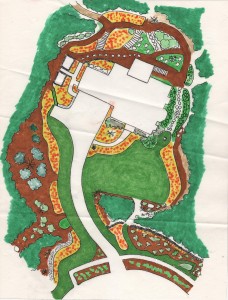 For a look at the garden on a more recent tour day (August 2011), click here.)
For a look at the garden on a more recent tour day (August 2011), click here.)
In 2008 we opened our property for the Garden Conservancy’s Open Days Program. This is a nationwide program that benefits the Conservancy’s efforts to preserve and refurbish ‘great’ gardens around the country that may otherwise be lost to neglect or development. We were one of six gardens selected in Boston’s western suburbs to be open that day. Here is what you would have seen if you were here. For a more current look at the garden, please visit www.BettyofGardening.com. To see any of the photos and diagrams below at full-screen size, double-click on the image.
15 Wild Holly Lane – A Self-Guided Tour
We lived at this address from 1999 until 2015, when we ‘downsized’ to ‘only’ an acre and a half of land and a brand new garden. As you peruse this page, be aware that we don’t live here any more. Worse, the new owners more or less bulldozed the garden (and an adjoining acre of trees) in order to plant…. grass.
So, what you see here no longer exists. Instead, it’s a record of Betty’s previous ‘garden of record’. The creation of the new one is being chronicled in my blog. When it starts looking good, I’ll update this page with photos and diagrams.
As a starting note, we’re not environmental purists, but we’ve worked to make the garden we’ve created both ecologically sound and sustainable. As such, this description will be peppered with descriptions of ways we’ve tried to achieve that environmental awareness. What follows is a walk around the property with a few photos to show you how the garden looked on that day.
The Xeric Garden (at left) at the front of the property acknowledges the reality that, in building streets and sidewalks, developers dump all the crud from the project at the front of the property, level it, and then thrown on a layer of asphalt. Until we put in the xeric (Greek for ‘dry’) garden, nothing grew here except weeds. It gets all-day sun, there is no water, and the ‘soil’ is sand and rock – with a generous helping of salt because the town pushes up snow here in the winter. Last year, we planted this mix of drought-tolerant plants which are now thriving. (In 2009, the bed has been extended across the front of the property such that it now stretches in an arc more than 120 feet long.)
The Flowering Shrub Bed (part of which is seen at right) is now in its eighth year. This area was once grass. Now it offers four seasons of interest (in winter, the red twig dogwood and Devil’s Ninebark, among others, stand out, and the Witch Hazel blooms in February). Most of the shrubs are native alternatives to invasive species. The golden spirea, Carolina sweetshrub and potentilla are currently in bloom. The Fothergilla and Itea are stunning in the autumn.
The Manhattan Bed (in the foreground of the photo at right and so named for its shape) will be alive with daylilies – next week, unfortunately. In the early spring it has a large number of hyacinth and daffodils. Later this summer, the asters will be in their glory. As autumn progresses, the grasses will develop their plumes and provide structure to the bed through the winter.
The Butterfly Bed (not shown) offers a plethora of plants to attract bees and butterflies – and add lots of summer color. Behind it is the dry creek bed which absorbs runoff and shows what you can do with several thousand small rocks that would otherwise collect in piles. The Chinese Fringe tree just finished blooming.
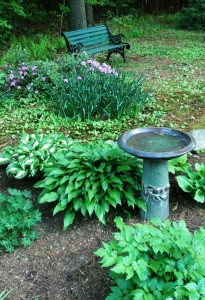 Moving up the driveway, the wettest part of the property is this small ‘bog garden’ that currently sports May Apples and ferns. Later this summer, the May Apples will give way to Eupatorium (Joe Pye weed). Behind it are a series of specimen trees and shrubs. Feel free to wander this area.
Moving up the driveway, the wettest part of the property is this small ‘bog garden’ that currently sports May Apples and ferns. Later this summer, the May Apples will give way to Eupatorium (Joe Pye weed). Behind it are a series of specimen trees and shrubs. Feel free to wander this area.
Shade Bed 2 (shown at left) is comprised principally of New England natives. You’ll find pink and white turtlehead (Chelonia) (the latter is the only food for a Massachusetts native butterfly), American ginger, tiarella, Rodgersia and aruncus (the plant with the very tall plumes).
The tree on the opposite side of the driveway from Shade Bed 2 is a forest pansy redbud. It is a wonderful native understory tree that blooms in the spring and then produces dark red, heart-shaped leaves until nighttime temperatures are above 70 degrees.
Shade Bed 1 starts the spring with a variety of native ephemerals including bluebells. Now, they are covered by astilbe, hosta, and meadow rue. The large-leafed plants in the back of the bed just starting their growth spurt are ligularia, which will top out with beautiful yellow plumes later this summer.
In front of the house are the Inner Sidewalk Bed and Outer Sidewalk Bed (two photos at right). The oxydendron now in the center of the inner bed replaced a 50-foot-tall clump birch last year. As such, the character of the bed has changed from part shade to sun-loving plants. The outer bed is our interpretation of the classic English cottage garden. Both beds begin blooming in early April and provide color well into the autumn. Many plants are tagged for easy identification.
The Transplant and Nursery Beds (at left) are the working parts of the garden. Here is where sick plants come to recover and ‘dislocated’ plants await a permanent home. We provide more than a hundred plants each year for the Medfield Garden Club spring plant sale. Here is where those plants overwinter. The composter at the rear of the bed is the same one the Garden Club sells each year under a state program. We have a new supply coming in next week. They’re $35 each.
The four Rock Gardens (below, right) behind the house are an attractive solution to a serious problem. We bought the house in February and moved in on April 1. With the melting snow, we discovered deep gullies and badly eroded soil – a product of the 15 degree slope of the land as it goes down to Danielson Pond. The builder had sprayed grass seed – which had washed down into the woods. The previous owners had applied mulch – which also washed into the woods. Our first project was to install a series of gutters and underground drains to carry the water away from the house (and water the gardens). The rock gardens were built atop the drains to control erosion.
Rock Garden 1 and Rock Garden 2 (below and at right) feature soil-retentive ground covers such as creeping thyme, interspersed with Lewisia and other flowering plants. Rock Garden 3 is principally flowering shrubs. The plant with white flowers is itea ‘Henry Garnet’, the low perennial with yellow flowers is Lady’s Mantle (Alchemilla mollis). Rock Garden 4 is a dry shade bed with a large cornus mas (Cornelian cherry) at its center. While the rock gardens can be appreciated at ground level, we invite you to come up on the deck to see them as we do from our home.
Seed Eaters Heaven is our gift to the birds with whom we share this property, and who provide months of insect patrol. It is filled with seed-bearing flowers beginning in late July and is never cut down until the following spring.
The Hosta Walk (at left) is now four years old and coming into its own. There are 60 to 70 named varieties of hosta here. This is the north side of the property and it gets little sun, making it perfect for most hostas.
At the end of the hosta walk on the house side are a series of Mountain Laurel currently in full bloom.
Old Stone Bed (left), by contrast, gets full afternoon sun and provides common and uncommon perennials from early May into October. The low red flowers in the center of the bed is Maltese Cross, a neglected heirloom. The tall, bamboo-like plant on the right hand side of the bed is a hellenium that blooms in late September and October with clusters of sunflower-like flowers.
The lawn merits a few special notes. First, we’ve reduced the amount of grass on the property by nearly half during the past nine years. As we expand existing and add new shrub beds, we will reduce the lawn further. Second, this is not a ‘four step’ lawn. It has been deliberately overseeded with clover and is mowed to three inches, then allowed to grow to five or six inches (clippings stay on the lawn). We apply lime liberally in the spring and fall, but fertilize only once with a 10-10-10 mixture in the spring. In times of drought, the lawn goes brown. Rain greens it up quickly.
Click here to see an archived copy of the Wall Street Journal article on ‘hell strips’ that features our garden.
